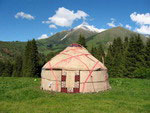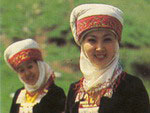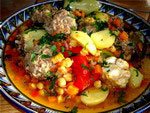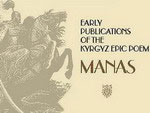Yurta
 |
| source: allrussian.info.ru |
The invention of an easily assembled and reassembled house, made of felt, called a yurta, is the most remarkable achievement of the Kyrgyz nomads. A nomad could find shelter in a yurta from summer heat and rain and winter frosts. Today the yurta is popular with chabans (shepherds), who spend their summers in the high pastures (jailoo).
The basic rule for erecting a yurta is that the door should always face South or Southeast. The interior of a yurta is divided into functional zones. The "Red Corner" of the yurta is opposite the door where the trunks and chests with the main family valuables are kept. Blankets are also stacked in the same area. The middle of the yurta is occupied by the fire and a low table. The right-hand side of the yurta is the female area and the household utensils and children's things are placed here. The left-hand side is the male part where saddles, bridles and other male items are stored.
National clothes
 |
| source: terra-minora.ru |
Like in the history of other nations, in Kyrgyz culture of ancient times social status was reflected by the costumes.
Woman’s costume was changed depending on the periods of her life:
Shekelo is an ancient traditional veil of the bride.
Elechek is the high hat of married adult woman made on the dense basis. It is spooled from the stripe of white canvas or cotton. The length of stripe was more than 7 m and was defined by social status and wealth of woman. Elechek was used as a sheet after woman’s death.
Chyptama – this kind of clothes was made with necessary ornament. It looks like waistcoat.
Famous Turkic men’s trousers were made from rawhide. The Kyrgyz were known as good furriers.
Food and drinks
Cuisine
 |
| source: dom.a42.ru |
Meat, milk, vegetables, fruit, and pastries are the traditional products used in Kyrgyz cookery. Beshbarmak (Five fingers), is the most popular traditional, national dish. At official feasts and celebrations it may only be prepared by the men - the sheep's carcass is stripped of the remaining meat and this is mixed with noodles and herbs and served as a soup-like dish. The most festive of the main courses is Shorpo – meat broth with vegetables and spices. The favorite drink is kymyz. Kymyz is made from fresh mare's milk, which is poured into a special leather bag - and is then stirred with a special wooden stick, which is called "bishkek". The name of this stick is given to the current capital of the Republic.
Boorsoks – pieces of dough fried in oil;
Chuchuk – fat salami made of mutton;
Chak-chak – sweat meal of fried dough with honey.
Shashlik – meat roasted skewers.
Lagman – strong ragout with cut pieces of meat, vegetables and species poured onto long handmade noodles.
National beverages:
Kymyz – fermented mare’s milk – quite useful and nutritive drink.
Maksym – beverage made of the best sorts of barley, wheat or corn.
Manas epic poem
 |
| source: unesco.kz |
The national historical epic poem Manas was dedicated to the national brave hero Manas who protected Kyrgyz land and his nation since ancient times.
It is a kind of steppe “Iliad”. This epopee depicts the Kyrgyz people’s way of life, customs, traditions, morals, religious rituals, geographic and medical knowledge, diplomatic relations with other countries and people.
The Kyrgyz claim that three nights are not enough to narrate the epic Manas. And at the moment it’s the longest epic in the world. It contains about a million of lines.
Only a person who has a rich spiritual inner world who knew aspirations of his people, their legends, tales, family trees, traditions and customs, who had a talent and certain mysterious power could be a narrator of Manas – manaschi as Kyrgyz call such people.

